THE INTERNATIONAL SITUATION IN 1881
Colonel Urabi’s Revolt in Egypt. Britain was mainly involved in colonial conflicts throughout the 1880’s with no direct actions in Europe. In 1881 there was an uprising in Egypt over foreign debts that couldn’t be paid. Colonel Urabi led a revolt and the ruler Tewfik Pasha agreed to the Colonel’s demands which essentially meant independence and not paying the debt. However the British and French who were owed the money pushed back against the agreement. For the British access to and control over the Suez Canal which had been completed in 1869 and their trade routes to the Indian Ocean was a big factor. The situation was resolved by a British invasion in 1882, the French didn’t want to be involved. The British captured Urabi and exiled him to Ceylon (present day Sri Lanka). Egypt effectively from that point became a British run colony until 1952.
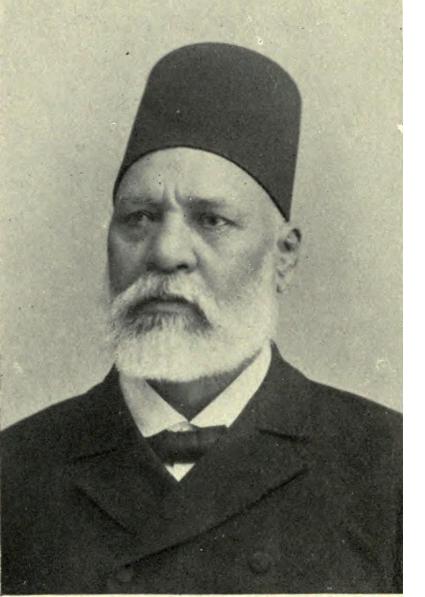
The Beginnings of the Mahdist War. 1881 also saw unrest in the Sudan. The Mahdi, Mohammed Ahmed, had been preaching for the renewal of faith and liberation of Sudan from Egypt for over a decade. In 1881 three Egyptian expeditions were slaughtered by the Mahdi’s followers. Britain was drawn in from 1882 as Britain was from then effectively ruling Egypt.
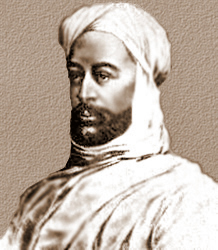
THE 1881 CENSUS
The 1881 census was taken on 3rd April and showed a general increase in the population of the Three Towns although Devonport fell slightly for the second decade in a row but as the area was mainly supporting the Dockyard it probably reflected a stable workload that didn’t require any expansion of the workforce. The overcrowding situation hadn’t improved with the number of new houses only keeping the numbers per building the same as a decade earlier but the increase intensified the pressure on the water and sanitation services as well as the public institutions. In Plymouth the population increased to just over 75,000 from just under 69,000 with an average of 9.5 people per house. Devonport dropped 700 people to 18,745 with an average of just over 11 people per house whilst Stonehouse went up by just over 500 to 15,125 and just under 11 people per house. In all of the Three Towns females slightly outnumbered males. Over 15,000 marriages took place over the decade, 7,556 in Plymouth, 1,657 in Stonehouse and a further 6,134 in Devonport.
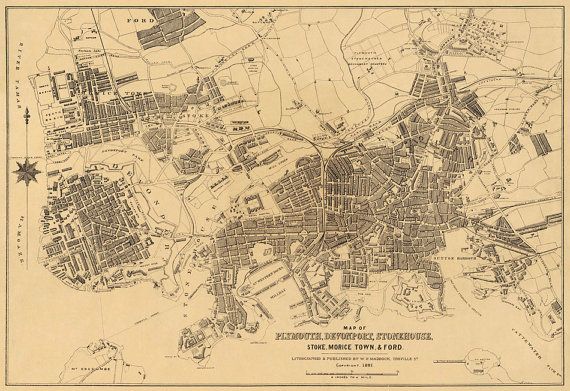
Ratepayers paid 3d in the £ and the poor rate was a further 1s in the £ per year. This contributed to the institutions and staff the Corporation wholly or partly funded. A number of other institutions being wholly or partly funded by private subscriptions. Some institution also charged for their services to offset running costs. The situation in some of the institutions was as follows but as the census is taken as staying overnight it would most likely reflect the night shift only and not any increase in daytime staff nor the daytime management and administrative staff. In Plymouth the Prison held 52 inmates, 38 male and 14 female looked after by 9 warders, 4 male and 5 female. The Plymouth Workhouse held 619 inmates, 304 male and 315 female with 6 male and 10 female staff on duty. Over in Devonport the Workhouse had 351 inmates, 157 male and 214 female looked after by 16 staff split down the middle with 8 male and 8 female. Stonehouse had 89 inmates housed in their Workhouse, 33 male and 56 female with 6 staff, 3 male and 3 female looking after them. The workhouses would also have provided poor relief to a far larger number of the population who had their own place to live. The larger numbers of female inmates compared to male reflects that it was a largely male working environment, especially those with a decent wage. If the male wage earner was injured, died or simply neglected to provide for or abandoned the family, which was not uncommon, then they were unlikely to have any sort of income to fall back on unless they had sons or daughters at work. Even though it was an offence to neglect your family and people were prosecuted it was all too easy to end up on poor relief or in the Workhouse itself. There were some treats for the inmates on special occasions and at Easter in the Plymouth Workhouse the inmates were given Hot Cross Buns which according to the Press reports particularly pleased the lunatics although I have no idea why it pleased the lunatics more than the other inmates!!
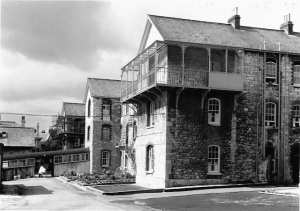
There were 11 in patients, 6 male and 5 female at the Royal Eye Infirmary with 4 staff, I male and 3 female looking after them. Over at the South Devon Hospital 21 staff, 3 male and 18 female were looking after 75 in patients, 48 male and 27 female. In Devonport the Royal Albert Hospital looked after 106 in patients, 26 male and 80 female whilst in the Female Military Hospital there were just 2 in patients although 1 of them was male who had 4 staff to look after them. At Stonehouse there were 383 all male in patients at the Royal Naval Hospital with 165 staff to look after them, 92 male and 73 female. The staff on duty were the night shift so probably excluded the bulk of the surgical teams and staff that looked after the out patients. The Sailors Rest Home supported over 32,000 sleepers over the year as they were paid off from one voyage and looked for another ship as well as the individuals and families that had fallen on hard times. There were also 81 Brothels with 427 common women or women of ill-repute as they were known at the time operating in the Three Towns. All were privately funded institutions!! They were legal although there were restrictions on how and where both brothels and prostitutes could operate.
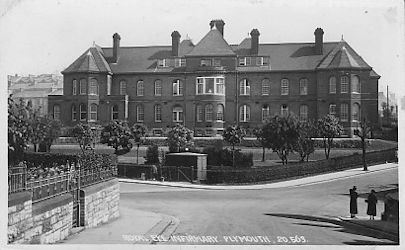
The Police Forces also reported annually. I can’t find one for every year and the numbers don’t fluctuate wildly between the years I have found in any case. There is no report from Stonehouse as it was part of H Division of the Devon Constabulary which covered a larger area than just Stonehouse whereas Plymouth and Devonport had their own Borough Police. In Plymouth the Force was 91 strong headed up by a Chief Constable who commanded 4 Inspectors, 7 Sergeants, 76 PCs and 3 Detectives. There were 50 assaults on the Police over the year and the summary offences included Common Assault including assaults on Women (31 cases); Cruelty to Animals (8 cases); Prostitution (13); Offences Against the Education Acts which would be truancy or keeping children from school (34); Drunkenness or Drunk and Disorderly (362); Offences under the Police Act (196); Embezzlement (4); Offences under the Licencing Act (17); Permitting Drunkenness (7); illegally Selling Liquor (7); Neglecting the Family (8); Larceny or petty theft (133); Army Act (3); Vagrancy (14); Begging (54); Breach of the Peace (2) and Embezzlement (4). Of those bought before the Magistrates and found Guilty the punishments included imprisonment of 1 to 6 months for 54 with another 190 sentenced to 1 month or less. 503 were fined, 17 were whipped, 2 were returned to the Military Authorities with 1 child sent to the Reformatory and another 20 sent to Industrial Schools. Both Reformatories and Industrial Schools were similar aimed at providing delinquent and destitute children with an education, skill and moral training to help them get a job and integrate into wider society so the focus tended to be on the industrial skill. The schools tended to be single sex with separate Girls and Boys schools and were run as voluntary institutions albeit with legislation about how they could be run. Plymouth would get its own Industrial schools in 1882. There were 102 indictable offences over the year which went before the Crown Court. However there were only 50 arrests so not all crime was solved. Amongst the cases were 2 of Murder of Infants, 1 of Sodomy or Bestiality, 18 of Fraud, 4 of Housebreaking, 2 of Burglary, 3 of Attempted Suicide and 11 of keeping a disorderly House. Additionally within the Plymouth Borough 1,672 persons were sent to the Workhouse over the year and 242 vagrants were given shelter in the Police Station. Devonport’s 50 man Force was led by a Head Constable who commanded 3 Inspectors, 5 Sergeants, 39 PCs and 2 Detectives. The summary offences were similar to those in Plymouth. 697 people ended up before the magistrates with 455 men and 169 women convicted whilst 73 men and 41 women were found Not Guilty. Of those the Police classified them as 12 male and 3 female thieves, 45 Prostitutes, 54 Vagrants, 169 habitual drunkards and 58 suspicious or bad characters. 38 received sentences from 1 to 6 months and 114 spent less than a month in jail. 388 were fined, 5 were whipped and 1 returned to the Military. 2 children were sent to reformatories and 3 to Industrial schools. There were 33 indictable offences for which 13 people were apprehended and 9 committed to trial.
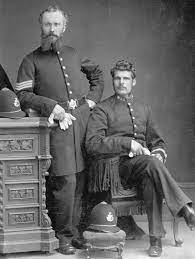
To give an idea of the Military numbers there were 3,083 shore based personnel but this is just the numbers within the Three Towns and doesn’t include any of the outlying forts and defensive positions. It also doesn’t reflect the large number of part time militia and reserves who would be recorded at their own homes and using their civilian occupation on the census. On the 12 Naval ships anchored in the Sound there were 3,866 personnel aboard. Most were Training Ships, permanently moored flagships or Guard Ships (fixed floating Gun Batteries guarding the entrance to the Sound). These included the Training Ships Implacable and Impregnable with a combined 1,832 trainees and staff on board and the Training Brig Nautilus with another 106 trainees and staff. The Nautilus was a reasonably frequent albeit unintentional visitor to the Island running aground on the foreshore on more than one occasion. The largest ship was the flag ship of the Port Admiral at Devonport, HMS Royal Adelaide an old 104 Gun wooden sail first rate warship. She was classified as a Depot ship so a fixed station and permanently moored rather than a fighting ship from 1860. HMS Cambridge with a complement of 549 personnel was a Gunnery Training Ship and like the Royal Adelaide permanently moored in Plymouth’s waters. As far as Merchant shipping was concerned there were 1,142 merchant seamen on 178 vessels either tied up or anchored in Sound and the associated ports and harbours. In the Devon Artillery Militia Depot there were 34 people in total housed. 9 were serving full time Militiamen from the HQ Company including our Regimental Sergeant Major Richard Routledge now aged 49. Richard was living there with his wife Mary Ann and 9 of their children so about a third of the population of the Depot were Routledges!! The Childers reforms slightly changed the terms of service to a maximum of 12 years of which 5 could be with the reserve. Soldiers could reenlist at the end of the 12 years. Reorganisation of the Army also continued. The Artillery Militia was now reorganised into 11 Divisions of Artillery. The Militia Regiments became Brigades within those divisions and the Devon Artillery Militia became the 3rd Brigade Western Division RA in 1882. The Divisions were reduced from 11 to 3 in 1889 when county titles were adopted again with the 3rd Brigade retitled the Devon Artillery Western Division RA. Largely this was just a name change so the effect on Richard’s working day would be minimal. However there were changes to the Army Service Corps which supplied the Army which would have changed the way supplies were ordered and delivered. Of the Routledge children who had grown into adulthood and still living at the family home Emily Emma was now 22 and working as an Upholsteress, 21 year old Eliza was helping Mary Ann running the home, Annie who was 18 was a student teacher, 17 year old Frederick Richard had got an apprenticeship as a Plumber and 15 year old Maud was also apprenticed but as a Milliner. The other 4 children, Rosina (13), Charles (11), Albert Thomas (8) and Lilian Violet (3) were all at school.
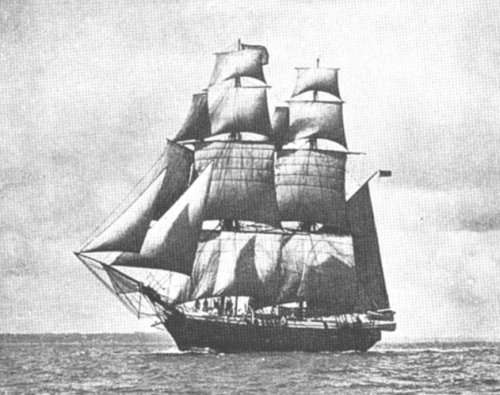
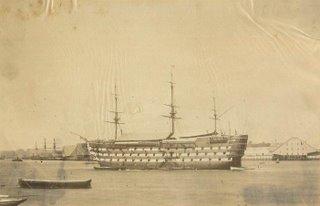

William, Richard and Mary’s eldest gave his occupation as Trumpeter in the Devon Artillery Militia but it is not clear if this was his main occupation. He was living with his wife Caroline in shared accommodation at 62 George Street in Devonport. They had 5 children by this stage Thirza (8), William John (6), Alfred Ernest (4), Blanche Mary (3) who were all at school and 1 year old Sydney Robert. Richard’s second born John is serving abroad as a Leading Seaman on HMS Griffon just off the British Virgin Islands and Montserrat in the Caribbean. By coincidence the Capital of Monserrat was Plymouth until it was destroyed by a volcanic eruption in 1995. John’s wife of 2 years Mary 1879 and first child Beatrice aren’t recorded in the 1881 census but are recorded in later census. Mary Jane the eldest was living with husband Charles Maynard, a local shipwright down the road from William also in shared accommodation at 13 George Street with their 8 month old first born, Ethel.
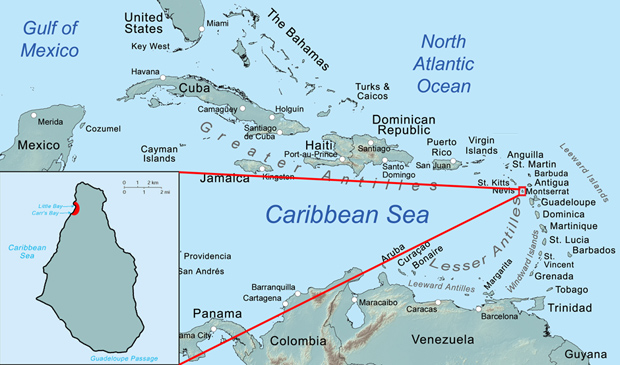
Over on the Island there were 50 Gunners, the Master Gunner and his assistant plus a 48 man detachment from the Citadel. There were 6 military families quartered on the Island together with the family of the Canteen Manager and Lessee. The Island was still used as a location for the annual training of various reserve units. As on the mainland they would have to be ready for the inevitable round of annual inspections. One of the additional duties the detachment had was firing a gun three times a day so the townspeople and more importantly mariners could accurately set their watches. Having the accurate at Greenwich meridian was crucial for navigation at sea, the most important of these was the One O’Clock gun.
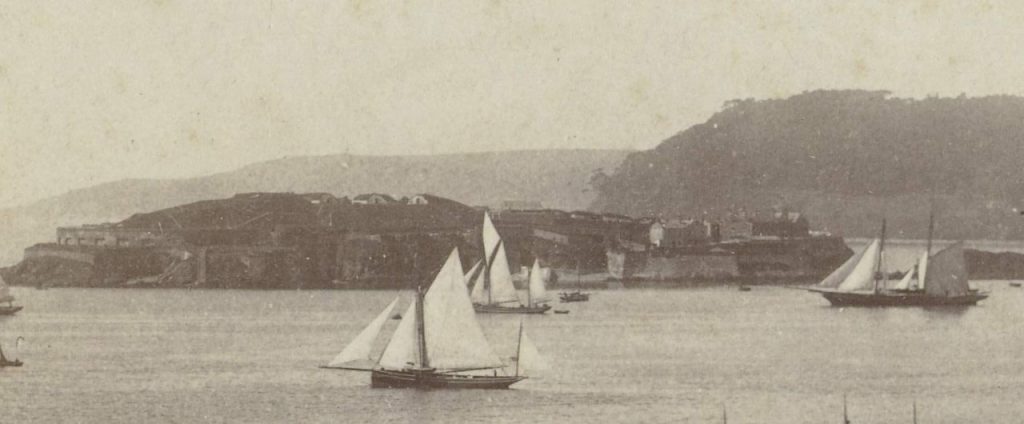
To get around town the horse buses were running and a horse tram that linked the Three Towns. Ferry services along with boatmen also provided a waterborne service around the Sound. For entertainment Military Bands regularly performed in the Guildhall which held regular Saturday performances by both Military and civilian bands which would feature a variety of artists from singers to comedy monologues and skits. Shows were also held in the theatres in the Three Towns with the Theatre Royal which had opened in 1813 having a capacity of 1,200. Shows would also form part of society meetings such as the Temperance Society as a means of encouraging people to attend and listen to the lectures. The Devonport Amateur Dramatics gave their first performance in 1881 to add to the options for entertainment and a Marionette (puppet) troupe gave a number of performances at St James’ Hall. For the more high brow there were Art Exhibitions at times throughout the year and a Plymouth Debating Society to discuss important topics of the day. Devonport Albion and Plymouth were the leading Rugby clubs but there were a significant number of others playing regularly. Rugby was more popular than Association Football in the South West. A number of the clubs also played Cricket in the Summer and there was a Plymouth Bicycle club that ran races that began on the Hoe. Annual Regattas which were the culmination of the sail race season continued to be watched by large crowds around the Sound.

Various Bakers, Cooks and Confectioners delivered throughout the Three Towns from Horse drawn Vans and there was an Ice Company that delivered Block Ice throughout the Summer. Water was a problem during the summer of 1881 due to a drought. This meant water supplies were only available between 8am and 2pm daily. The drought also bought to the fore the pressure the expanding population was putting on the sanitation system. The main disposal of sewage was by outfall pipes directly into rivers and the Sound although there were some sewage tanks where chemicals were added before the waste drained onto the ground. In Plymouth there were outfalls into the Cattewater and Sutton Pool whist over in Devonport both Devonport and Plymouth sewers had outfalls into Stonehouse Creek which was known locally as Deadman’s Bay. At the heads of some creeks such as Stonehouse Creek and in both Sutton Pool and Mill Bay waste had accumulated to a depth of several feet that were exposed at low tide. It was universally recognised as a health issue but with three different boards responsible together with other boards responsible for outlying areas that would also discharge into the rivers that fed into the Sound a coordinated solution was difficult. Initially it was decided to build longer outfall pipes to discharge further out into the Sound and the Devonport Board wished to clean Stonehouse Creek. Complaints from the Harbour Commissioners were also increasing adding to the pressure to find a solution.
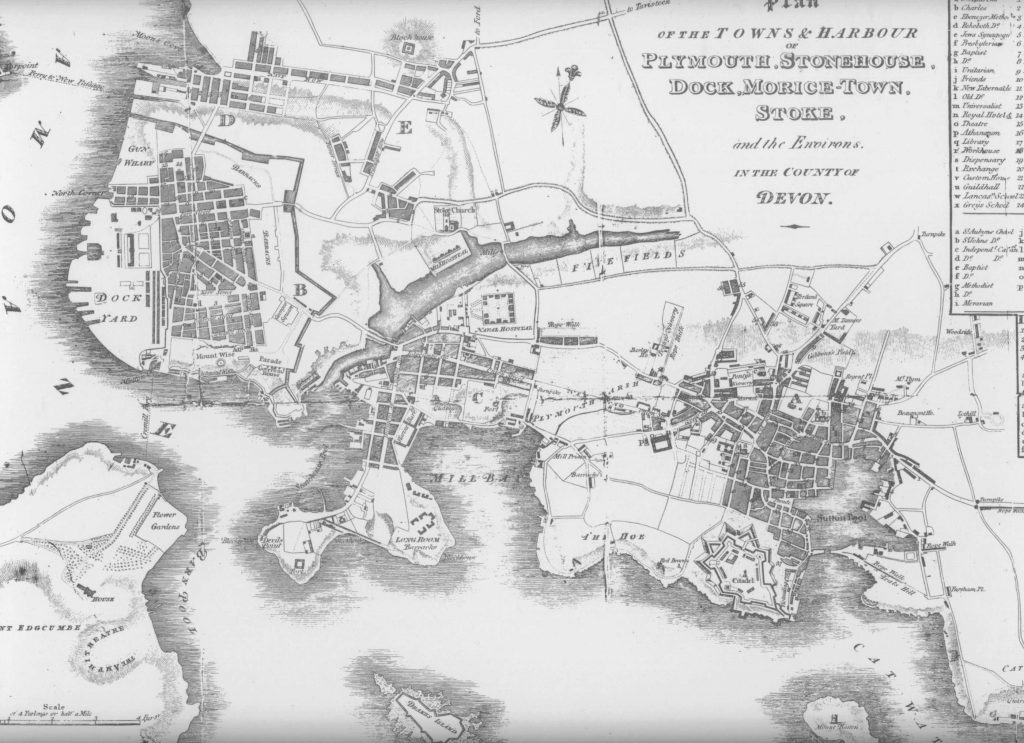
May saw a large review of troops at Devonport, including the Devon Artillery Militia for the Queen’s Birthday. The total number of troops involved was well over 1,600 and included 27 horses. The Naval ships in the Sound also played their part in the spectacle. The Royal Salutes from both the shore and ships were fired at noon. No doubt this occupied a fair bit of RSM Richard Routledge’s time over the previous few weeks. A month later the Militia was on annual camp. The schedule hadn’t changed the recruits formed up for training prior to the trained Militia forming up. The main camp for both the newly trained recruits and those already qualified was 3 weeks over which the men would be put through various gun drills in the defences around the Sound. There would also be the round of annual inspections to prepare for throughout the year.
1882 Starts with Sewage Problems
With the sewage problem not having been resolved and complaints increasing, proposals were developed for subsiding tanks to cope with overflow and a sanitary works at Mill Bay.
Boys Reform Schools Built.
In 1882 to help cope with juvenile crime Plymouth opened a Boys Industrial School in Laira House on Embankment Road. Mr Kirk was appointed as the superintendent assisted by his wife and Mr MacCarthy, a Navy pensioner all of whom lived on the premises. There were 19 beds in one large dormitory for boarders and also six cells where trouble makers could be held. The rooms were heated and in addition there were ablutions including a hot and a cold bath and a dining-room with kitchen. There was a large outside space mainly used for drill which was regarded as a method for instilling teamwork and discipline. There were workshops for trade training and a garden for growing vegetables. The boys would have school and book work for around 3 hours followed by work or skill training in the workshops and very occasionally play periods. The School could care for 36 boys but they had to be over 8 and under 14. The School opened with 6 boys in attendance. The Boys wore an issued uniform and only had their own clothes returned to them when they left the school. A Girls Industrial School opened a year later.
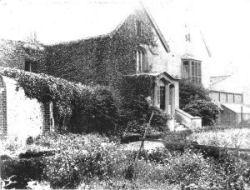
Rebuilding the Smeaton Tower on the Hoe
The Smeaton Tower was originally built on the Eddystone in 1759 but had by now been replaced. The plan was to demolish the Smeaton Tower by explosives to prevent it being a danger to the new lighthouse. However sufficient funds were raised by subscription to have the Tower dismantled and rebuilt on the Hoe to replace the Naval Navigation Obelisk. The lower 19 courses or first 20ft of the original tower were not removed but were reproduced using Dartmoor granite. The remaining 60ft of the Tower was the original on the Eddystone. The tower was officially opened on 24th September by the Mayor.
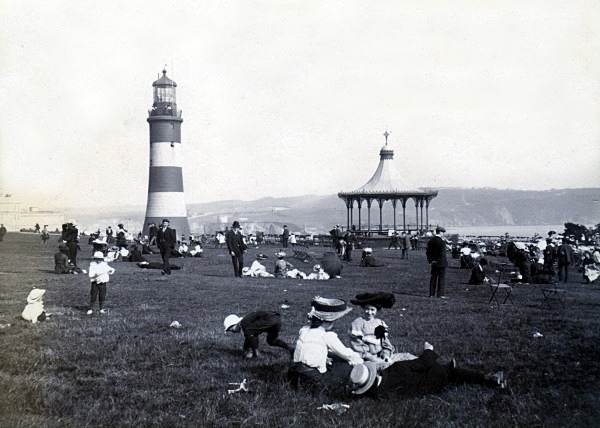
Drake’s Island Crumbling
Newspaper reports complained that the defences on Drake’s Island were crumbling and would only be of use against older frigates with old armaments. The Palmerstone Fort programme was never completed and although the defences on the Island were complete not all the guns were delivered. As the French threat had disappeared and no new threat had become apparent it is unsurprising the defences had been neglected. Britain’s default position tended to be to do the minimum until a threat became apparent. The Palmerstone programme was the only large scale defence programme undertaken but had run over budget and was becoming obsolete before it was finished, hence they are often known as the Palmerstone Follies. Nevertheless gun practice was still carried out on the Island but was limited to blank rounds. Adverts were still taken out in the papers giving the firing times and warning people to leave their windows in case the concussive effect even from the blank rounds caused them to shatter. Live firing was only allowed from the forts further away from the Three Towns and firing into the sea.

More Drake’s Island Births
Harriet Hunter was born on the Island in 1882. Harriet was the eldest of three children born to Master Gunner William Hunter and his wife Sarah on the Island although they had at least six children in all. William was discharged from the military by 1891 when the family was living in the Mount Edgecumbe Inn where William was the publican. They were still at the Inn in 1901 but by 1911 William had moved the family up to Norfolk and was earning a living as a Farmer. Harriet was still with the family for the 1901 census but I can find no record of her in the 1911 census, it is quite possible she had married by this stage. Marian was the second Hunter born on the Island in 1884. She is listed on the 1911 census living with her father William working as a Dairymaid on his farm in Norfolk and was unmarried. Ernest was the third of the Island Hunters born in 1886. He was with the family in 1891 and 1901 but by 1911 was married to his wife Myrtle and working as an insurance salesman in Southsea, Portsmouth. On the outbreak of World War I in 1914 he volunteered for the Royal Garrison Artillery. He was deployed to France and Flanders in 1915 and was unfortunately killed in action in June 1915.
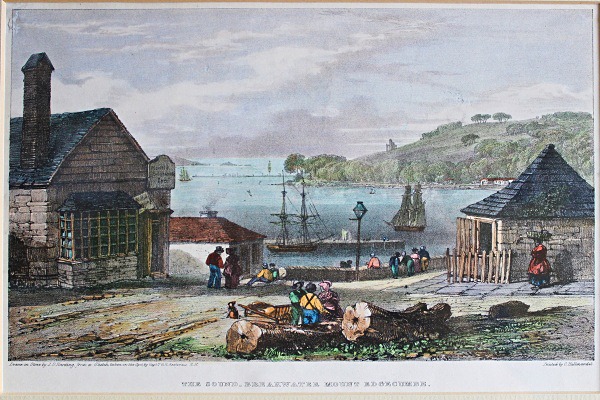
Devonport Free Library Opens
Over in Devonport the Mechanics’ Institute in Duke Street which held books and artefacts had closed in 1881 but was bought by the Devonport Corporation. It reopened in February as the Devonport Free Library and Museum. The Library had a Lending and Reference section, Reading Rooms. The artefacts together with others that had been donated were displayed along the gallery. Thomas Lakin was appointed as the first Librarian. 1882 also saw the Devon Artillery Militia renamed as 3rd Brigade Western Division Royal Artillery (WDRA). This was part of a general reorganisation with the various militia Regiments becoming Brigades within a Home Division. Meanwhile John Routledge and his wife Mary had their second child who they christened Edith.

1883 – Sewage Floods in the West End
The sewage problems worsened as there were sewage floods in the western half of Plymouth. There was no resolution for another couple of years and the West End was still suffering floods with raw sewage invading the houses in Flora Street, Bath Street, Bath Lane, Octagon Street and Rendle Street in 1885.
The Mahdi Defeats another Expeditionary Force
The Egyptians were effectively ordered by the British to send yet another expedition, the 4th that decade to the Sudan to defeat the Mahdi. Like the others this one, twice the size of the previous expedition and 8,600 strong was also defeated.
RSM Richard Routledge Drowns
August was a sad time for the Routledges. The family Patriarch Richard was out sailing his yacht near to Cawsand when it capsized. Unfortunately Richard was unable to swim and drowned as he struggled to reach the safety of the shore. I am not sure how long his Widow Mary Ann and the rest of the family living at the Devon Militia Depot would have had to vacate their quarters but I doubt they would have been given more than a few weeks. Their daughter 21 year old Anne who was training to be a teacher got married in the same year to an Army Schoolmaster Thomas Ferris. Anne moved with Thomas to India where he was posted to an Army School in Madras. There was also a happier event for William and Caroline who had their 6th baby, a boy Claud Hamilton Percy.
The Late Firing of the One O’Clock Gun
There began to be complaints including from the Chamber of Commerce about the late firing of the One O’Clock gun from Drake’s Island. The procedure was that a telegraphic communication would be sent to Mount Wise from the Greenwich Observatory when it was time to fire the gun. Immediately a cone would be dropped from the signalling mast at Mount Wise which was the signal for the gun to fire on the Island. This relied on the Gunner on the Island being able to see the cone which was often impossible in bad weather, the gun being ready to fire and the Gunner actually looking at the signalling mast at the time the cone fell. It seems it was becoming a regular occurrence that the gun could be up to 10 minutes late especially if the Gunner on the Island couldn’t see the signalling mast and was guessing the time!! They didn’t fire from Mount Wise as the Island was the point from which all the ships and the Three Towns could hear the gun, a gun at Mount Wise wouldn’t have that range.
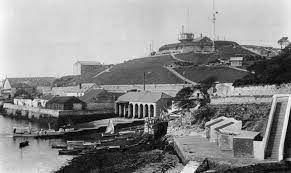
1884 – The Mahdi Slaughters General Gordon and the Khartoum Garrison
With the Egyptians unable to deal with the Mahdi the British now decided to resolve the issue and sent in General Gordon to oversee a orderly withdrawal from the Sudan which held no strategic interest for Britain. Gordon’s problem was that the size of the Sudan left the garrisons vulnerable to attack once they left the fortified defences. The reasons why Gordon became besieged in Khartoum are debateable nonetheless he, the garrison and European population, the largest in Sudan were surrounded and besieged by March. In early 1885 after a 313 day siege and with disease rife the Mahdi’s forces broke through the defences and slaughtered over 7,000 including Gordon and the garrison. The British did not get involved with the Sudan again until the 1890’s.
Drake’s Statue on the Hoe Erected
Back in 1881 it had been decided to launch a subscription to erect a statue of Sir Francis Drake as a national monument. The response had been weak and only a few hundred pounds was raised. The Duke of Bedford stepped in and paid for the statue that was put up in Tavistock. However the Duke allowed a replica to be cast and it was this bronze replica that was unveiled on the Hoe on 14th February. The base is Aberdeen granite and was designed in Plymouth by Hine and Odger who worked out of Lockyer Street. There were about a 6,000 crowd to watch the unveiling including Royal Naval Engineering College students and around 2,000 school children given time off to watch several bands, the guards of honour from the Naval Reserve, Highlanders and Marines together with the 17 guns on the Hoe that fired a Salute during the ceremony.

Plymouth’s Promenade Pier Opened
29th May was the grand opening of the Promenade Pier in Plymouth after 5 years work including a change of contractor and a cost of 45,000. The deck made from pine was some 20ft above the high water mark. The whole structure including the circular end was 420ft long. There was a reading room, stationary and bookstall, slot machines and refreshment rooms. Iron stairs led down to landing points for steamers. The Mayor with the Band of the Royal Marines playing unlocked the gates to formally open the pier in front of around 30,000 people of which 10,000 made it onto the pier.
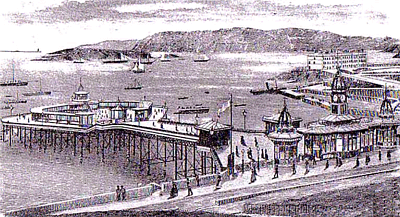

July 1884 saw a brief unintentional visit to the Island by the Navy Training Brig Nautilus. It was returning from a training cruise when it got too close to the Island and ran aground. Fortunately it was on a rising tide and she got off quickly without any damage.
To help cope with the ever expanding population in Plymouth at the end of the year a new telescopic gasholder was put into operation at the Plymouth Gas Works to expand the capacity. At the time it was the largest holder west of Bristol, supported by 16 huge iron columns and 32 trellis wrought iron girders which used over 600 tons of iron during the construction.
1884 saw a change in voting eligibility with the passing of the Representation of the People Act. This now extended the vote to any male holding land valued at £10 or more or paying a yearly rent of £10 or more. The average wage was around £50 per year though there were wide fluctuations. Women were still barred from voting and 40% of the male population was still without the vote.
Eliza Routledge, one of Richard and Mary Ann’s children got married in 1884. Unfortunately the record doesn’t state who she got married to and this is the last record I can trace of Eliza.
1885 – 3rd Anglo Burmese War
Yet another conflict over trade between Britain and France was played out in a third country. The British issued an ultimatum in 1885 demanding control over foreign policy and commerce to have exclusive access to Burma. The King of Burma refused and the British used the Indian Army to launch a quick waterborne invasion using the rivers which were the quickest means of getting around the country. The King had no time to mobilise the Army before the British arrived in the capitol leaving the King no option but to surrender. 1st January 1886 saw Burma formally annexed although there were insurgencies up until 1896.
Militia Called Up
With other minor expeditions draining the Regular Army’s manpower the decision was taken to call out some of the reserves including 3rd Brigade WDRA. Although RSM Routledge had passed away his eldest William was still serving so would have been called up in March. The crisis passes quickly however and the Brigade was stood down 6 months later without deploying. Mary Jane William’s sister who married Charles Maynard had their second child another girl who they named Violetta.

Plymouth gets a Telephone Exchange
New technology continued to arrive in the Three Towns and the Telephone Exchange opened in 1885 after a false start a few years earlier. The Western Counties and South Wales Telephone Company took over the dormant infrastructure and obtained a licence. They took on private as well as business subscribers and began operating in February 1885.
A new cleaning service became available when the Plymouth Sanitary Steam Laundry in Elm Street became operational. It offered a carpet beating and laundry, including family washing, service with a collection and delivery service offered to all parts of the Three Towns.
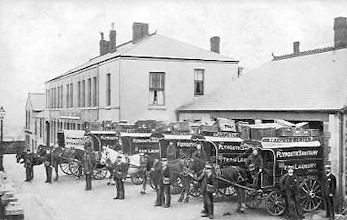
There was an addition to the local ferry services when the Millbrook and Devonport Pedestrian Ferry began operation.
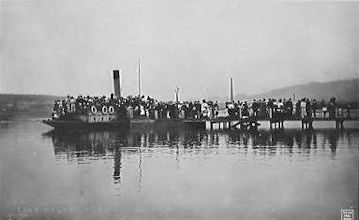
Late 1885 saw tenders being asked for the construction of the sewage works at Mill Bay including sewage reservoirs for treatment and outfall pipes.
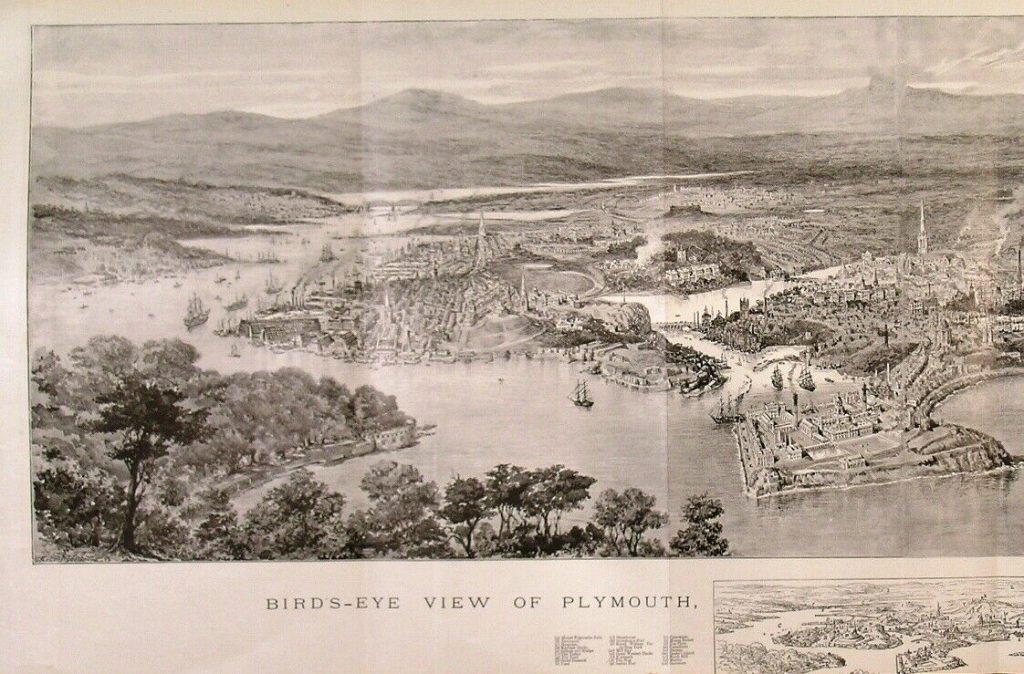
1886 – Ear and Throat Hospital Opens
July 1886 saw the Devon and Cornwall Ear and Throat Hospital open in Union Street. At the outset only out patients were treated as funds weren’t sufficient for in patients. The patients also had to contribute towards the cost of their treatment. 361 cases were treated in the first year mainly ear issues. The senior medical team consisted of a consulting doctor, a consulting surgeon, 2 surgeons and a dentist.
John Routledge Dies
This was another sad year for the Routledges, John R unfortunately passed away in 1886 whilst serving in the Navy. There is no record of the cause of death but an accident whether on or off duty must have happened. He left behind widow Mary and their 2 children, Beatrice now 6 and 4 year old Edith. Mary remained in Plymouth and managed to support the two girls through school by working as an Upholsteress. William and Caroline had their 7th child another boy who they named Albert Robert.
More Complaints about the Lateness of the One O’Clock Gun.
Over on the Island following more complaints about the late firing of the One O’Clock gun an electric clock connected to the Greenwich Observatory was installed at Mount Wise was installed so the signal would be given at the exact moment. This still relied on the Gunner on the Island seeing the signal and the complaints continued. The Training Brig Nautilus paid another surprise visit to the Island. Returning from a cruise up the channel strong winds blew her onto the foreshore where she needed the assistance of 2 boats to tow her off. Fortunately no damage was sustained during the operation. The contract for works also came up for the Island along with other defences in the Devonport and Plymouth area.
HMS Impregnable Replaced
HMS Impregnable was replaced by HMS Howe which was renamed HMS Bulwark as one of the Navy Training Ships anchored in the Hamoaze. Later in 1888 the old Impregnable was renamed HMS Kent and HMS Bulwark – the old HMS Howe was renamed HMS Impregnable.
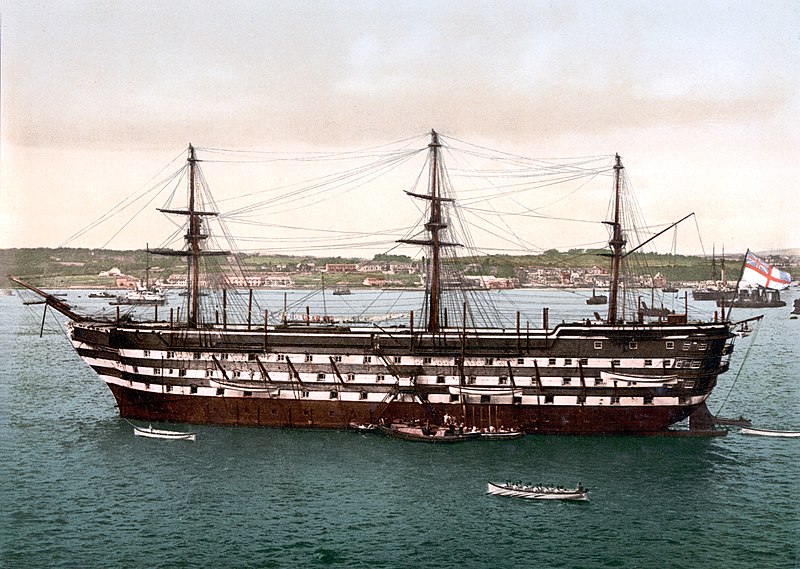
Plymouth Argyle Founded
Although the Rugby teams had been founded 10 years earlier Association Football was gaining in popularity in the Three Towns partly as it was more popular in the Army than Rugby. Outside of the Three Towns most of the football clubs after the two codes were formalised opted for the Rugby code. Plymouth Argyle was founded in 1886. The founders met in the Borough Arms Coffee House to thrash out how the club would be run and the rules. The original name was just Argyle Football Club and they first practiced on Freedom Fields and they initially had no home ground, there was limited open space in Plymouth. The first match was a loss against Dunheved College away at Launceston. The popularity of the game was highlighted as a second XI was formed and started playing matches during that first season. All matches at this stage were arranged challenge matches, there were no leagues and the only competition was the FA Cup. The club had occasional use of Freedom Fields and Mount Gould for home matches but most of the 17 1st team fixtures were away games. The earliest colours were a Black with a green sash from one shoulder to the opposite hip. Over in Devonport on the Rugby front Devonport Albion absorbed the Keyham club. They still played at Devonport Park and were charging spectators 3d to watch.
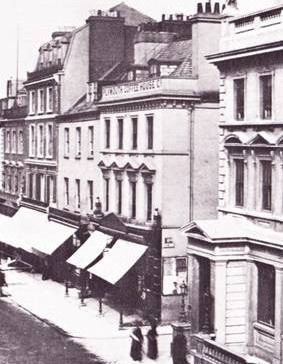
1887 – Sewage Works not Complete
The Sewage works were still not complete, the West End was still suffering from overflow problems. Compton Gifford added to the problem by dumping into the Laira and onto neighbouring fields. Although Devonport had stopped dumping into Stonehouse Creek Plymouth Borough continued to do so so the issue with Deadman’s Lake continued.
During 1887 the Police Superintendent became responsible for commanding the Fire Brigade in the town.
Promenade Pier Auctioned and Sold
Meanwhile the pier appeared to have hit financial problems and was put up for sale at auction. Eventually John Kay, a fish merchant, paid £12,000 for the pier. The pier was refurbished with paint and varnish, concessions to the various shops and kiosks were leased out, admission was 1d, pleasure trips were restarted and bathing tickets sold. The pier also became a limited company with 8,000 shares sold. It appears it was a successful investment plan as net earnings in 1889 were reported as £1,800.
During August a pinnace from HMS Shannon was bringing Officers back from a run ashore in Plymouth when she ran onto the foreshore of the Island and was holed. Other boats from the Shannon took the crew and passengers off. The pinnace was recovered the next day and taken for repairs. In December the decision was taken to stop firing the time gun from the Island. Mount Wise would take over the duty so at least it could be relied on for accuracy even if it was out of hearing range for part of the Three Towns.
Mary Jane Maynard (nee Routledge) Passes Away
Sadly Mary Jane Maynard, Richard and Mary Ann’s daughter who had married Charles Maynard passed away aged only 30. There is no cause of death given but it was presumably illness or an accident.
Devonport Albion Move Ground
Devonport Albion were by now becoming quite successful and were looking to move from Devonport Park to a larger ground. They settled on Bladderly Lane, now Beacon Park Road and the 1891 season saw a crowd of 3,571 watch the home game against Barnstaple.
Gales Damage Drake’s Island
Over on the Island the March gales washed away one of the Island boats and damaged the landing place. Another gale in November saw the sea wash completely over the Barracks and do some considerable damage to them.
1888 – Devon FA Founded
Early in the year there was a meeting of all the major Football teams in Devon with the aim of forming a County Association to play inter county games and administer the game within Devon. Plymouth Argyle, Plymouth United, Tavistock Grammar School, Mannemead School, Newton, Carlton Oaks and Plymouth College were the founding members who agreed to a subscription of £1 annually towards costs. The first match would be played against Somerset with trial games on the 15th and 18th of February beforehand. Devon lost the game 2-0.
There was another arrival for William and Caroline, their 8th, a baby girl Ida Lucy.
Devonport formed a volunteer Fire Brigade with 2 manual engines. Previously the town had relied on the Navy and Dockyard Fire Engines to deal with any fires.
The sewage issues at Stonehouse Creek were partly resolved as Plymouth came to an agreement with Devonport to connect to the Devonport Sewage system that had an outfall further out into the Sound. Although some improvements had been made to local sewers heavy rains caused yet another sewage flood in some basements in the West End of Plymouth.
The Sikkim Expedition
Sikkim in northern India was the closest province to Tibet and had close ties to it but with an undefined border. Tibetan forces had occupied the important road links in Sikkim and had been collecting taxes since 1884. The British sent an expedition in 1888 to reassert their authority which defeated the Tibetans who then withdrew. The conflict was formally resolved with the Treaty of Calcutta in 1890 that confirmed the border and the Tibetans formally renounced any claims on Sikkim.
Marine Laboratory and Aquarium Opened
30th June 1888 saw the opening of the Marine Laboratory and Aquarium in Plymouth where the current Marine Biological Association overlooks the Sound from the Hoe in front of the Citadel. The building which used Devonian limestone had taken a year to construct. The Association was founded in 1884 and chose Plymouth as the site for the laboratory and aquarium due to the variety of wildlife and habitats plus the direct proximity to salt water. There was a tank on the ground floor for the Aquarium fed by underground reservoirs that held up to 100,000 gallons of seawater. The seawater was continually cleaned and pumped back into the tanks. Admission was free when the Aquarium opened but would later make a charge. It closed in 1998 when the Aquarium became the National Marine Aquarium and moved to the current location on the Barbican.
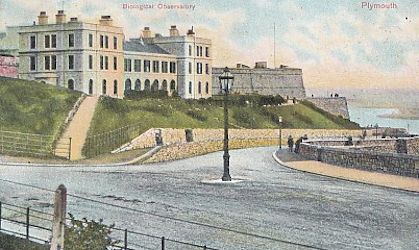
1889 – Sanitation Works finally Complete
The new sanitation works were complete at Mill Bay and the Laira issue had been resolved but there was still an uncoordinated response to a common problem which would continue to hamper the Three Towns when dealing with all major problems until the unification into one authority in the next century.
As an additional bit of comfort for their passengers Great Western Railways introduced gas lamps into their carriages over the course of the year.
Police Reports For Plymouth and Devonport
The Police reports for the year show the Police were still dealing with much the same offences and level of offences. The Devonport Force had increased by 4 PCs to a total force of 54 Officers whilst the Plymouth Force remained at 91 Officers. In Plymouth there were 111 indictable offences of which 48 went to trial and 1,082 summary offences which resulted in 927 convictions. Most were fined, 185 were sent to prison and 24 were whipped. Of the children 46 were sent to industrial schools and 2 to reformatories. Devonport dealt with 27 indictable offences and 7 went to trial. There were 764 summary offence with 674 convictions. There were 23 assaults on Devonport officers and 63 on the Plymouth Force.

Militia Reorganised Again
There was another reorganisation of the reserve forces in July with the 3rd Brigade WDRA renamed The Devon Artillery (WDRA). The main reorganisation was at Divisional level so the practical effect for the reserves in the Three Towns was minimal. In September a sports team from the Island took part in a military sports day at Fort Tregantle. The Tug O War team won their competition but were the only success for the Island.
Births and Marriages for the Routledges and Births on Drake’s Island
Yet another Routledge was born to William and Caroline, a girl they named Emily. Around this time William’s second born and eldest son William John would have joined the Navy as a boy sailor and began training on HMS Impregnable though not the one his uncle John had trained on. It must have been a tough year for Mary, not only had Richard her husband died but her son John and daughter Mary Jane now another daughter Emily Emma also died aged 31. Emily had been living with her mother at Benbow Street in Devonport when she died. There was also another Routledge marriage, 23 year old Maud (Richard and Mary Ann’s daughter) married George Mounstephen.
Over on the Island there were two births during 1889. Kathleen J Allen is registered in the Armed Forces Births Register as being born on Drake’s Island. The 1901 census shows her aged 11 living with her father William, a Gunner, and mother Jane in Rame, Cornwall. The family was in married quarters at the Brennan Torpedo Station at Piers Cellars.
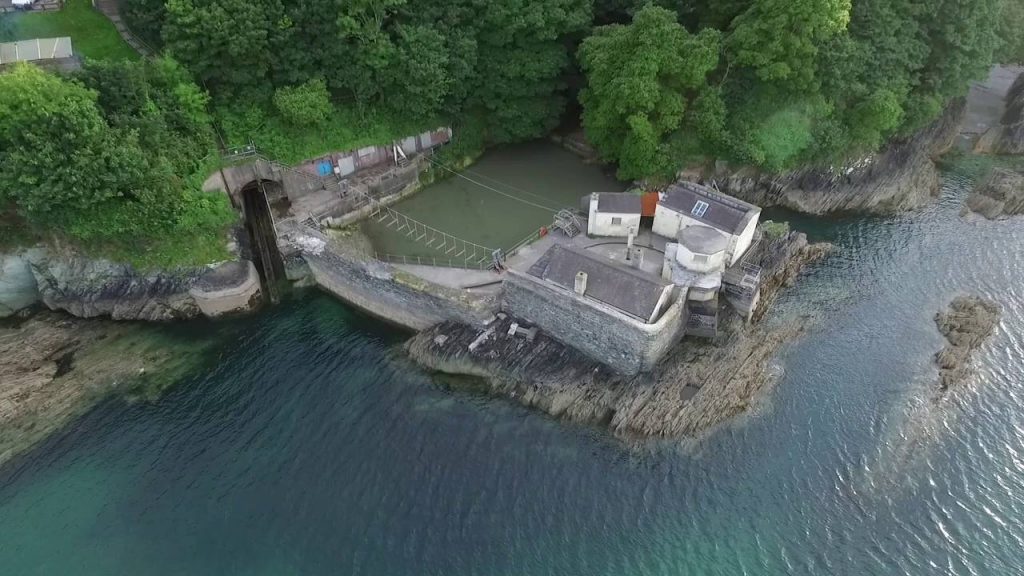
Vincent Drake Spice is quite intriguing. His father, Alfred Thomas Spice was definitely serving with the Royal Artillery when Vincent was born. The Register of births has the abode as Devonport and the family home was given as Mount Wise Barracks when he was baptised. However his middle name seems to be have been given in recognition of the Island. Although middle names were often the mother’s maiden name in this case his mother’s maiden name was Godwin and not Drake. It is quite possible Vincent was born on the Island if the family were detached to Drake’s Island or if they moved back just after the birth. Either way it appears Alfred left the military soon after Vincent was born and the 1891 census shows the family living in Southampton with Alfred living on his own means, in other words looking for work after his discharge. This and subsequent censuses, the 1939 Register and Vincent’s military record all show his birth place as Drake’s Island. The 1901 census shows Alfred was employed as a Railway Clerk and the family still living in Southampton. He died in 1910 by which time Vincent had followed him into London and South Western Railway also as a clerk living with his widowed mother in Southampton. Vincent was called up in 1916 aged 26 when conscription became compulsory and served in the Army with the Devonshire Regiment and later with the Royal Army Service Corps until discharge in 1919. The 1939 Register, a World War II register shows Vincent still working as a Railway Clerk in Southampton. The register shows him cohabiting with Cora Physick who he eventually married in 1947. Vincent passed away in Southampton in 1956.
1890 – Brave Rescue by an Island Gunner
Gunner Dawson who stationed on the Island was crewing the Island boat carrying a group of Officers and Gunners from Mill Bay back to the Island. Gunner Kelly fell overboard and was rescued by Gunner Dawson who was recognised by the Humane Society. Another Routledge christened Jack Dart was born to William and Caroline. Dart was Caroline’s maiden name whilst Maud and George Mounstephen had their first daughter Hilda.
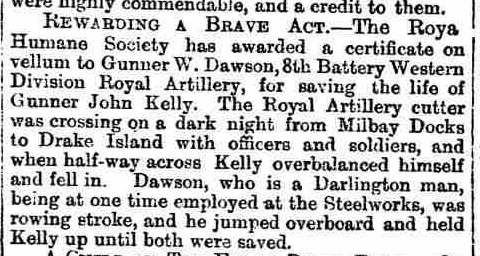
The Routledges during the 1891 Census
Richard had died in 1883. He was originally part of the Island Garrison back in 1851 as a young 19 year old from Cumbria who met and married Mary Ann. Richard was on the permanent staff of the Devon Artillery Militia and he settled with Mary Ann at the Militia Depot in Devonport. They had 12 children in all 3 of which, John, Mary Jane and Emily all died before the census. Mary would have had to move out of the married quarters at the Militia Depot not long after Richard’s death. In the 1891 Census she is living at 21 Benbow Street in Devonport with 4 of the children. 27 year old Frederick who is earning a living as a painter, Rosina now 23 and assisting in running the home, 21 year old Charles who is working as a caulker and 13 year old Lilian who is at school. They share the house with Charles Maynard and his family. Charles had married Mary Jane, Richard and Mary Ann’s daughter, but who had passed away in 1887. Charles was still working as a Shipwright and his 2 daughters 10 year old Ethel and Violetta 6 were both at school. It would seem to be a mutually beneficial arrangement with Mary and Rosina looking after the home and school aged children with three incomes coming in.

William (Richard and Mary’s eldest) and Caroline are living at 23 St Levan Road in Devonport. William is a mineral oil dealer, the census doesn’t say if he had remained as a trumpeter in the Devon Artillery or whether he left during one of the two reorganisations. All their children were still living at home except William John who was a 16 year old boy sailor in the Royal Navy on HMS Impregnable. Thirza was 18 and working as a domestic servant and apart from 1 year old Jack the remaining 7 children, Alfred (14), Blanche (12), Sydney (10), Claud (8), Albert (5), Ida (3) and Emily (2) were all school. William must have been doing ok for himself and the family as they weren’t sharing the house with any other families.
Mary, John’s widow had now moved to shared accommodation at 13 George Street in Devonport which was where Charles Maynard and Mary Jane had lived previously. Mary along with her 2 daughters Beatrice (10) and Edith (9) only had 1 of the 6 rooms, the Beglehole family had 4 rooms and the Tiddicks the other one room.

Anne was living with Schoolmaster husband Thomas Ferris in Madras, India where their daughter Dorothy was born in March 1891. Maud was with her daughter Hilda and husband George Mounstephen in shared accommodation at 111 Wilton Street in Devonport where they had 3 of the 7 rooms. George was employed as a Railway Clerk.
It’s not clear where Albert is at the time of the census. We do know he marries and is in Ireland by the time of the 1901 census but 1891 is a mystery.
The 1891 Census on Drake’s Island
The Island was manned by Master Gunner John Morgan who had his own Boatman and a 66 man Gunner detachment. There were 3 Officers, all 2nd Lieutenants so it is not clear who was in command although the real power probably lay with Battery Sergeant Major Payne. Additionally there were 2 Sergeants, 3 Corporals, 3 Bombardiers, 1 Acting Bombardier, 52 Gunners and a Trumpeter. The largest contingent, 12 were from Yorkshire although 20 English counties were represented along with Scotland and Ireland but no Welsh. There were also a couple of servicemen born overseas in India and Bermuda and one of the sons was born in South Africa. There were 3 military families quartered on the Island along with the Canteen Lessee’s family. In addition to the 4 wives there were 3 daughters and 10 sons. In total there were 91 people on the Island. If anyone is looking for an ancestor that served on the Island the full census is below together with what, if any, details I managed to find about them.
Detachment
2nd Lieutenant Percy Thorney Ayre; Unmarried; 20 years old; born Hull, Yorkshire. Percy had been promoted to Lieutenant in July 1893 but died in 1895 in Patrington, Yorkshire.
2nd Lieutenant Herbert Walter Bowen; Unmarried; 20 years old; born India. Herbert was promoted to Lieutenant in July 1893. He married May Cambridge in 1902 and had a daughter Carlotta in 1913. Herbert served in World War I and was awarded the Distinguished Service Order as a temporary Lieutenant Colonel in 1918 whilst in Mesopotamia, current day Iraq and parts of Iran, Syria, Kuwait and Turkey. The DSO at that time was only awarded to Officers for distinguished service during wartime usually under fire. Herbert was still serving in 1921 but was retired living in Twickenham with Wife May and daughter Carlotta in 1939. Herbert passed away in 1944.
2nd Lieutenant Arthur Noel Davidson; Unmarried; 19 years old; born Cheltenham, Gloucestershire. Arthur was promoted to Lieutenant in February 1894.
Battery Sergeant Major Charles Sampson Payne; Married; 34 years old; born Bristol, Gloucestershire. Annie Payne; Wife; 25 years old; Hubberstone, Pembrokeshire, Wales. John C E Payne; Son; 7 years old; Hubberstone, Pembrokeshire, Wales. George Payne; Son; 5 years old; Hubberstone, Pembrokeshire, Wales. Annie M Payne; Daughter; 3 years old; Hubberstone, Pembrokeshire, Wales. Just after the Census Alison E Payne was born on the Island to Charles and his wife Annie. The family was in Tynemouth by 1893 but may have been abroad for the 1901 census. Charles was discharged in 1903 and the 1911 census shows the family living at Alverstoke in Hampshire and Charles is registered as a military pensioner. He did however reenlist aged 60 for World War I and served on the home front in the Royal Garrison Artillery throughout the war. It appears Alison married Frederick Turner in Portsmouth in 1917 but I have no further information.
Sergeant Frank Squibb; Unmarried; 26 years old; born Cowes, Isle of Wight, Hampshire. Frank enlisted in 1884. He was posted abroad to Halifax Nova Scotia in 1885 and was promoted to Acting Bombardier in 1886 then Bombardier in 1887 and later the same year to Corporal before returning to Britain. In 1890 he was promoted to Sergeant and married Annie in 1892 in Devonport. Frank and Annie were posted to Pembroke where their first born, Frank Gloyn arrived in 1894. In 1897 Arthur George came along and Frank was promoted again to Company Quarter Master Sergeant in 1899 but must have disliked the job he was doing as he soon reverted to Sergeant at his own request. Olive Emily Lizzie was their third child who was born in 1902 and finally Frederick James arrived in 1903. Frank was discharged in 1907 and was awarded a pension of 29d per day for life and the family moved back to Plymouth. In 1911 he was living at 55 Whittington Street in Pennycombe Quick working as an Assistant Librarian. 17 year old son Frank was apprenticed as a Boilermaker in the Dockyard whilst the other three children were all at school. The family was still in Devonport in 1921. Frank passed away in 1934.
Sergeant Walter Morgan; Married; 25 years old; born Mowbray, Gloucestershire. Alice Morgan; Wife; 27 years old; born Nova Scotia. William Morgan; Son; 4 years old; born Nova Scotia. Ellen Morgan; Daughter; 2 years old; born Devonport, Devonshire. By 1911 William had been discharged and was working as a Gardener in Walton, Suffolk. His eldest son William was working as a Shipbuilders labourer. Ellen must have married as she is not listed but there were another 4 children, Alfred Walter who was 19 and working as a Milkman, Gladys Dorothy (13), Gertrude Edna (11) and Charles Edward (5) who were all at school.
Corporal Charles Mason; Married; 27 years old; born Liverpool, Lancashire. Charles enlisted in 1886 and was posted to Halifax, Nova Scotia for two years during which he was promoted to Bombardier. He was made Corporal in 1889 and was then posted to Sierra Leone from 1892 to 1893. In 1894 he was convicted of Drunkenness and reduced to Gunner before being transferred to the Reserve. He was discharged in 1898.
Corporal William S Sedger; Unmarried; 21 years old; born Bermuda
Corporal James T Bowhay; Unmarried; 21 years old; born Devonport, Devonshire. James enlisted as a Boy soldier and Trumpeter aged 14 in 1883. He served in Bermuda form 1884 to 1885 then in Halifax NS until 1887. He was made Acting Bombardier in 1887 and then passed the Clerk’s course and was promoted to Bombardier in 1888. He was promoted to Sergeant in 1893 and married Elizabeth Webb at Pembroke in 1895. She passed away the same year not long after they wed whilst giving birth. It was a double tragedy for James as the child was stillborn. James got remarried Sarah Mary Jane Fraser at Pembroke in 1897. James was in Mauritius from 1898 to 1902 during which time he was promoted to Company Sergeant Major. Not long after his return to Britain he went AWOL in 1904. He was subsequently reduced to Corporal after being convicted by Court Martial. He was then discharged at his own request. James found work as a Butchers Clerk and Cashier in Milford Haven. He was recorded in the 1911 census as working as a Fish Packer living with Sarah and his widowed brother William a Royal Navy Leading Shipwright. Also with the family was William’s son Arthur a teacher and his colleague William Richards who was lodging with them.
Bombardier Robert J Richards; Unmarried; 32 years old; born Ireland
Bombardier William Wrisberg; Unmarried; 22 years old; born Coshbould, Worcestershire. William married Sarah Jane Cobley in 1892. They had a daughter Lotty in 1894 and a son Frederick in 1895. William was a Warrant Officer and the family were in Married Quarters at Weymouth in 1911 by which time Lotty was a Student Teacher and Frederick was just finishing at School. William was still serving when World War I broke out and was commissioned as a 2nd Lieutenant in 1915 as part of the Royal Garrison Artillery. He finished the War as a Captain and was discharged in either 1919 or 1920. William passed away in 1926.in Farringdon, Berkshire.
Bombardier Frederick J Meed; Unmarried; 23 years old; born Leicestershire
A/Bombardier (Master Tailor) John Edward Tamlin; Unmarried; 24 years old; born Torquay, Devonshire. John enlisted in 1887 and subsequently qualified as a Master Tailor in 1889. He was made Acting Bombardier in 1890 and married Catherine Hut in 1892 at Plymouth. By that time he had been promoted to Corporal having made Bombardier earlier in the same year. Unfortunately the couple’s first two children, Annie and Robert both died in 1894. John was promoted again to Sergeant in 1894. The family was in St Helena from 1897 to 1899 where son John Edward was born in 1898. The family was then posted to Dover where daughter Mabel Helena was born in 1900. John was discharged in 1908 not long after their third child Wilfred J was born. The family then returned to Plymouth where John became the Landlord at the Palmerston Inn in York Street. The 1939 Register shows John has retired and is living with wife Catherine at 24 Neswick Street. John passes away in 1944 at 42 Cotehill Avenue.
Gunner John Allen; Unmarried; 21 years old; born Scotland
Gunner Henry G Ambler; Unmarried; 22 years old; born Portsmouth, Hampshire. Henry enlisted as an 18 year old Butcher in 1886 originally in the Hampshire Regiment before transferring to the Royal Artillery in 1887. He married Louisa Munday in 1890 before being discharged as medically unfit with deafness in 1891.
Gunner William Bellamy; Unmarried; 20 years old; Ashby de la Rouche, Leicestershire
Gunner William G Beresford; Unmarried; 21 years old; born York, Yorkshire
Gunner Thomas Bourke; Unmarried; 23 years old; Almonsbury, Yorkshire
Gunner John Bowlan; Married; 38 years old; born Scotland. Edith Sussana Bowlan; Wife; 39 years old; born South Anklington, Essex. Helenor E Eastman; Daughter; 19 years old; born Chatham, Kent. Lydia Eastman; Daughter; 12 years old; born Devonport, Devonshire. Frank Eastman; Son; 9 years old; born Plymouth, Devonshire. John Bowlan; Son; 5 years old; born Plymouth, Devonshire. Willie Bowlan; Son; 1 year old; born South Africa. John was an 18 year old Collier serving with the Militia when he enlisted in 1871. In 1882 he deserted and was imprisoned. He married Susanna Eastman at Devonport in 1884 before being sent to South Africa until 1887 and then onto St Helena until 1890 where he fractured his left leg. Daughter Violet was born in 1892 before John was discharged in 1898. He must have passed away soon after as Sussana is listed as a Widow living in Devonport in the 1901 Census. Sussana is still in Devonport for the 1911 Census.
Gunner Patrick Casey; Unmarried; 26 years old; born Ireland
Gunner Arthur W Clarke; Unmarried; 18 years old; born Trowbridge, Wiltshire
Gunner John Coatesworth; Unmarried; 22 years old; born Durham, Bishop Auckland
Gunner George Cruttenden; Unmarried; 21 years old; born Hastings, Sussex. George was with a militia unit, the 4th Royal Sussex when he transferred to the Artillery in 1888. He was transferred to the First Class Reserve in 1895 but recalled in 1899. He was promoted to Bombardier and sent to South Africa to fight in the 2nd Boer War. He was awarded clasps for Cape Colony and Orange Free State before being discharged in 1901.
Gunner William Dawson; Unmarried; 24 years old; born Durham. William who had been recognised for his bravery in rescuing Gunner Kelly from drowning in 1890 had enlisted as a 19 year old in 1886. Although the census records him as single his military record shows he married Sarah Anne Price in 1886 although it is possible Sarah had passed away before the census. He spent his first couple of years in Halifax Nova Scotia before being posted to Plymouth. After his stint on the Island he was tried and imprisoned although his record does not say what the offence was. He spent 1892 to 1895 in Bermuda before being posted back to Halifax NS until 1898. He was discharged the same year.
Gunner John Dixon; Unmarried; 30 years old; born Ireland
Gunner Edward Doughty; Unmarried; 22 years old; born Bourne, Lincolnshire. Edward enlisted in 1887 and served in Sierra Leone from 193 to 1894. He was discharged in 1894 with a disability pension as unfit for service. He moved back to Lincolnshire living in Gainsborough where he married Charlotte in 1900 with who he had 3 children, Sarah Elizabeth in 1901, Charles Edward in 1903 and in 1906 Lilian May. Edward passed away in 1944 aged 75.
Gunner Porrit Foster; Unmarried; 30 years old; born Market Weighton, Yorkshire. The only thing I can find about Porrit was he married Mary Ann Thorn in Devonport during 1896.
Gunner Johnathon Garside; Unmarried; 18 years old; born Stockton, Yorkshire
Gunner Michael Goodman; Unmarried; 21 years old; born Whitechapel, Middlesex
Gunner Harry Greenwood; Unmarried; 20 years old; born Glasberfield, Derbyshire
Gunner Abraham Grey; Unmarried; 23 years old; born Colchester, Essex
Gunner John Gordon; Unmarried; 28 years old; born Manchester, Lancashire. John was a bricklayer by trade who enlisted in 1887 aged 24. Although he was in the 2nd Battalion Lancashire Fusiliers when he attested it seems it was a paperwork error as he was officially pardoned for enlisting in another Regiment whilst still serving. He served from 1887 to 1890 in South Africa and married Phillipa Stark at Devonport in 1892. He was subsequently posted to India from 1894 to 1896 when he was discharged as medically unfit with an inflammation of the bladder.
Gunner Patrick Gordon; Unmarried; 21 years old; born St Helen’s, Yorkshire. Patrick was another Militiaman and was with 4th Battalion Yorkshire Regiment when he enlisted in 1887 aged 18. He served in India from 1892 to 1896 and was discharged in 1899. He was recalled in 1900 before being finally discharged in 1907. He married Mary at Middlesbrough in 1898. He had 2 children with Mary, John born in 1898 and Rose in 1901.
Gunner William Haines; Unmarried; 22 years old; born Queenborough, Leicestershire
Gunner Frank Hazledine; Unmarried; 21 years old; born Lenton, Nottinghamshire. Frank was a Carter ans serving with the reserves in the 4th Battalion Derbyshire Regiment when he enlisted in 1887 aged 18. He married Emily Hawkes and was serving as part of the Sheerness Garrison in 1901.
Gunner Hubert C Hayson; Unmarried; 21 years old; born Mastock, Somerset
Gunner William Holberry; Unmarried; 21 years old; born Hull, Yorkshire. William enlisted in 1887 aged 18 whilst serving with the Militia. He was promoted to Acting Bombardier in 1893 then to Bombardier in 1894 and Corporal in 1895. By this time he was posted to Pembroke where he married Emma Hodge. A few years later in 1898 he was promoted to Sergeant then in 1902 was appointed Master Gunner 3rd Class. He gave 3 months notice to leave as of right in 1909 and was discharged. He re-enlisted at the outbreak of World War I and served in the Coastal Defence in Devon and Cornwall throughout the War finally being discharged in 1920. It seems his first wife Emma must have died or they were divorced some time before 1914 as his military records in 1915 show his next of kin as his wife Louisa. William passed away in Plymouth in 1928.
Gunner William Honey; Unmarried; 19 years old; born St Austell, Cornwall. William enlisted as a 19 year old in 1890. After his stint on the Island he served in Aden in 1892 then onto India until 1895 after which he ended up in Aden until 1898. He was transferred to the First Class Reserve in the same year but recalled for the 2nd Boer War in 1900. He was awarded the South Africa Medal with clasps for Cape Colony, Orange Free State and Transvaal before being discharged in 1902.
Gunner Phillip Hopkins; Unmarried; 20 years old; born Bideford, Devonshire
Gunner Edwin Housley; Unmarried; 28 years old; born Sheffield, Yorkshire. Edwin was a 24 year old Steel Smelter when he enlisted in 1886. He spent the first couple of years in Halifax Nova Scotia and was transferred to the First Class Reserve in 1893 before being discharged in 1898. He was recorded as an unmarried farm labourer in Sheffield during the 1911 Census.
Gunner Charles Jones; Unmarried; 19 years old; born Taunton, Somerset
Gunner William Henry Joyce; Unmarried; 29 years old; born Stamford, Lincolnshire. William was a 22 year old Painter when he transferred from the 2nd Leicestershire Volunteers in 1885. He was sent to India initially and served in the Burmah Camaign of 1885 for which he was awarded the Burmah Medal. After his time in Devonport and on the Island he was transferred to the First Class Reserve in 1892. He settled in Luton where he married his wife Annie in 1895. Their first child Maud arrived a year later. In 1897 he was due to be discharged from the Reserve but re-enlisted. In 1899 son Albert was born and in 1901 William was discharged for the Artillery. He was working as a House Painter when he volunteered on the outbreak of World War I and was enlisted into the 5th Battalion Bedfordshire Battalion. He was discharged again in 1915. The family was still in Luton in 1921.
Gunner William Lacey; Unmarried; 21 years old; born Hull, Yorkshire. The only thing we know about William is he transferred from the York Artillery Militia in 1890.
Gunner Thomas W Malcolm; Unmarried; 22 years old; born Redcar, Yorkshire. Thomas originally enlisted in the 4th Dragoons but bought himself out and then enlisted in the Royal Artillery in 1890 aged 22. He was in Bermuda from 1893 to 1895 after which he was discharged as medically unfit. He was listed in the 1911 Census as living in Yorkshire and working as a dock labourer.
Gunner William Mann; Unmarried; 26 years old; born Ireland
First Class Reserve in 1894. He married Henrietta Hubbard in 1895 in Derbyshire and moved to Bingley in Yorkshire where Rose in 1896, Ada (1898) and Ethel in 1900 were all born.
Gunner Alfred Masters; Unmarried; 28 years old; born Great Ressington, Gloucestershire. Alfred was serving with 4th Battalion Gloucestershire Regiment when he enlisted in 1887. He served in India from 1894 to 1899 and was discharged in 1901.
Gunner Bernard McCabe; Unmarried; 22 years old; born Wakefield, Yorkshire. Bernard was in the Militia serving with the 3rd Battalion Yorkshire Regiment when he enlisted as a 22 year old Iron Worker. In 1891 he deserted but was caught and imprisoned. After serving his sentence he was discharged as medically unfit.
Gunner Thomas J McCarthy; Unmarried; 20 years old; born Ireland
Gunner James McGuinness; Unmarried; 24 years old; born Skipton, Yorkshire
Gunner William Mills; Unmarried; 24 years old; born Stowmarket, Suffolk
Gunner John Narey; Unmarried; 21 years old; born Middlesex, London. John was a 21 year old labourer when he enlisted in 1890. He spent 1892 to 1898 in India after which he was transferred to the First Class Reserve. He was recalled on Boxing Day 1899 for the 2nd Boer War and was awarded clasps for Belfast, Cape Colony, Orange Free State and Laing’s Nek. Discharged in 1902 he moved to Newcastle where he married Jane Ann with who he had a daughter Elizabeth. John died in 1940 from cardiac failure.
Gunner William Opie; Unmarried; 20 years old; born Redruth, Cornwall. William enlisted in 1889 and within a year had been promoted to Bombardier. However in 1891 he bought himself out of the Army for £18. It seems he went to live in Cornwall.
Gunner Sigreil V Pearson; Unmarried; 20 years old; born Durham, South Shields
Gunner Thomas Pearson; Unmarried; 19 years old; born Penzance, Cornwall
Gunner George Pitts; Unmarried; 22 years old; born Market Harborough, Leicestershire. George was a 22 year old Groom when he enlisted in 1890. He served in India from 1892 to 1898 and was awarded the India Medal with clasps for Punjab and the NW Frontier. George was promoted to Bombardier in 1900 before serving in the 2nd Boer War. He was awarded clasps for Belfast, Cape Colony, Orange Free State and Laing’s Nek. At some stage he must have married as the 1939 Register records him as a widowed Boot Maker living in Northampton. George passed away a year later.
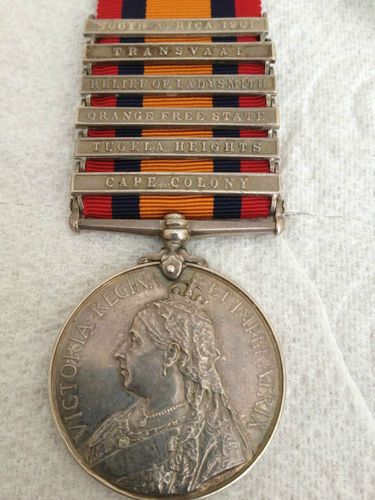
Trumpeter Frederick G Penkiman; Unmarried; 17 years old; born Middlesex, London. Frederick was just under 16 when he enlisted as a boy in 1889. From 1894 until 1904 he was serving in India during which time he was promoted to Bombardier, then Corporal and finally Sergeant in 1903. He spent just over a year in Malta during 1904 and 1905 before being posted to Newcastle. Discharged as medically unfit in 1909 he was awarded a pension of 21d per day for life. He got married in London during 1912 before settling in Eastbourne where he passed away in 1914.
Gunner Thomas Pouton; Unmarried; 18 years old; born Durham, Bishop Auckland
Gunner Thomas Rogerson; Unmarried; 18 years old; born Durham, South Shields. Thomas transferred from the Militia in 1890. He was tried and imprisoned twice in that year and again in 1892 after which he was discharged at Devonport as Incorrigible and Worthless. In 1901 he was 1 of 968 inmates doing time at Princetown, a civilian prison on Dartmoor. By 1911 he was back in his home town of South Shields having married Hannah with who he had a daughter Annie and working as a Blacksmith’s Striker.
Gunner Berham Slater; Unmarried; 21 years old; born Birmingham, Warwickshire
Gunner William Smith; Unmarried; 24 years old; born Morton, Lincolnshire
Gunner Thomas Sutton; Unmarried; 22 years old; born Leicester, Leicestershire. Thomas who trained as a shoe finisher enlisted in 1887 aged 19. He was promoted to Acting Bombardier in 1894, Bombardier in 1895 and Corporal in 1896. He served in South Africa from 1892 to 1899 when he was discharged. In 1901 he was back in Leicester living with his father and working as a labourer but shortly after married Priscilla. They had 5 children John Thomas Harold in 1902, Albert Edward a year later in 1903, Florence Natalhia in 1904, Edith May in 1906 and lastly Margaret Alice in 1910. The family had moved to Ratby in Leicestershire by the 1911 Census and Thomas was working as a quarrymen.
Gunner Frederick J Tuthill; Unmarried; 31 years old; born Ireland. Frederick enlisted aged 22 in 1881. He spent his first 3 years in India. By 1890 he had made Corporal but was tried for Drunkenness, found guilty and reduced to the ranks in 1890. He spent the next 2 years in Sierra Leone from 1890 to 1891 before his arrival in Plymouth. He was subsequently posted to Pembroke where he was promoted Bombardier in 1894 and then back to Corporal in 1897. A year later he married Caroline Francisca Upton and spent until 1899 in Mauritius after which he was discharged as medically unfit. The family settles in Pembroke where Frederick finds work as a Clerk. By 1911 are still living in Pembroke and have 4 children, Frederick R aged 13, Eileen Maria (11), Alice E (9) and Francis D (7).
Gunner Bryan Ward; Unmarried; 19 years old; born Market Harborough, Leicestershire. Bryan enlisted as a 19 year old in 1891. He served abroad in India from 1892 to 1895 being awarded the India Medal (clasps for NW Frontier and Punjab) before being transferred to the First Class Reserve in 1898. He was recalled in December 1899 and sent to South Africa to fight in the 2nd Boer War. He was awarded the South Africa Medal with clasps for Cape Colony and the Orange Free State. He was discharged after the War in 1902. He was recorded in the 1911 Census as an unmarried Barrow Filler in Scunthorpe.
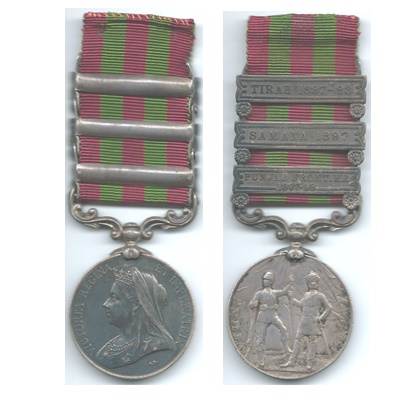
Gunner Thomas Ward; Unmarried; 22 years old; born Thornton, Leicestershire. Thomas enlisted aged 19 in 1887. He was promoted to Bombardier in 1892 and was transferred to the First Class Reserve. Thomas was discharged in 1899 and the family had moved to Basford in the Midlands by 1901 where Thomas had work as a Coal Miner. He was still in Basford in 1911 by which time they had another 5 children, Doris Elizabeth (1903), Hilda (1905), Gladys (1907) and finally twins John Thomas and Reginald in 1910.
Gunner Henry G Watson; Unmarried; 19 years old; born Aldershot, Hampshire
Gunner James W Wilkins; Unmarried; 19 years old; born Ulcombe, Kent
Gunner Alfred Gregory Williams; Unmarried; 20 years old; born Bodmin, Cornwall. Alfred, a Harness Master by trade, enlisted in 1889 aged 18. Just after the Census in 1891 he married Elizabeth Ann Matthews at Devonport. Their first born Albert came along in 1893 after which the family was subsequently posted to Pembroke where second son Reginald was born in 1895. He was tried for misconduct and imprisoned for 6 months in 1895 and discharged once he had served his sentence. The family moves back to Stonehouse where Lilian and Mabel are born in 1897 and 1899 respectively. Alfred is recorded as a labourer in the 1901 census. By 1911 they are living at 151 King Street, Plymouth. Alfred is now working as a Waggoner, Albert is a stoker in the Royal Navy, Reginald is an Errand Boy for the Daily Mercury whilst Lilian and Mabel are at school. There have been another 4 children born, Alfred George (1903), Archibald Thomas (1905), Ivy Doris (1907) and Ernest Gregory in 1910. Alfred’s wife Elizabeth passed away in 1914, Alfred is living in George Street Devonport in 1939 with a live in help, Bessie Birch. Alfred passed away in 1944.
Gunner John Wood; Unmarried; 22 years old; Leicester. John was a Baker who enlisted aged 18 in 1887. He was a Bombardier when he was transferred to the First Class Reserve in 1894 and was discharged in 1899.
Permanent Staff
Master Gunner John Morgan; Unmarried; 38 years old; born Manchester, Lancashire. John enlisted in 1871 aged 18 having worked previously as a labourer. He obviously didn’t enjoy his early taste of army life as he deserted in 1873 and was subsequently Court Martialled and imprisoned. On release he almost immediately went AWOL but seems to have settled down after that. He took part in the Afghanistan Expedition 1878-79 and was awarded the campaign medal with clasp Kandahar. On his return to Britain he was promoted to Bombardier in 1881 and then Corporal in 1882. He made Sergeant in 1883 then Battery Sergeant Major in 1884. He was appointed Master Gunner 3rd Class in 1887 and was posted to Sierra Leone in 1892 after his stint on the Island. He was discharged after giving 3 months notice in 1895 and received a pension of 48d per day for life.
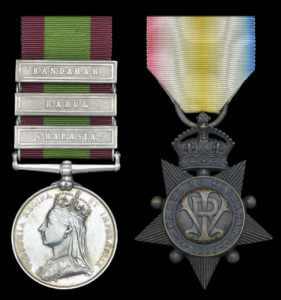
William Bailey (Boatman); Unmarried; 52 years old; born Almonsbury, Yorkshire.
John H Cross; Married; 45 years old; Canteen Manager; born Lydford, Cornwall. Selina E Cross; Wife; 35 years old; Plymouth, Devonshire. Edward J Cross; Son; 10 years old; Devonport, Devonshire. William J Cross; Son; 6 years old; Burmah. Frederick C Cross; Son; 5 months; Devonport, Devonshire. John McConnachie; Lodger; 24 years old; born Cardiff, Glamorganshire. The locations of the Cross Children’s births suggest that John had served in the military but I can’t find a military record for him.

